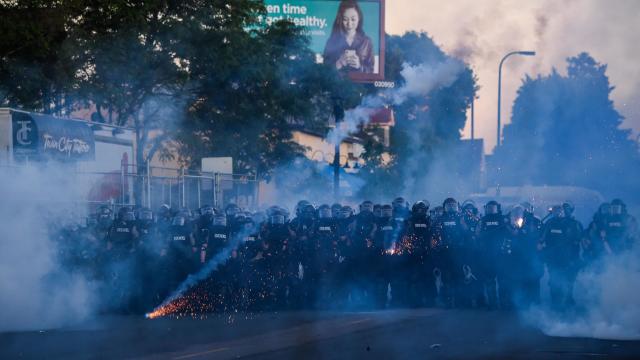Local police forces across the U.S. are turning to tech companies for “less lethal” means of subduing individuals that are even “less lethal” than what they have already been using. Instead of rubber bullets, tear gas, or pepper spray, police are looking into sound cannons, directed energy weapons, and projectile Kevlar cords, according to CNBC, because an increasing number of people are being seriously injured, or killed, by police misuse of these so-called less lethal weapons.
Amnesty International weapons investigator Brian Castner told CNBC said that police have been misusing “tear gas, pepper spray, pepper balls, 40-millimetre impact rounds, basically every combination of less-lethal weapon being used in inappropriate ways” in the nationwide protests following the death of George Floyd.
But instead of re-training their officers on how to appropriately use these devices (or actually training them not to purposefully antagonize and deescalate already tense situations), police departments want to turn to other, “less lethal” weapons. One of the more popular options is something called the Bola Wrap, which shoots 2.44 m Kevler cords around an individual to subdue them, theoretically without the need for a cop to exert as much physical force to restrain them.
Judging by the demo video on the company’s website, it appears less lethal, but not any less painful. Never mind the fact that the Bola Wrap still has the potential to be misused without proper training. It seems like it could be lethal if it were to, say, deployed around someone’s neck. As we have seen for years with tear gas, pepper spray, and impact rounds, it doesn’t do any good for police to have access to those items if they will intentionally, or even unintentionally, misuse them.
And just because a device is designed to be less lethal doesn’t mean it can’t cause irreparable harm or kill someone. A sound cannon, also known as a long-range acoustic device or LRAD, can emit high-pitched tones reaching up to 150 decibels on some devices. According to the CDC, anything 80 decibels and over can cause temporary or permanent hearing loss over a period of time. A concert, for example, is usually around 105-110 decibels, causing possible hearing loss in less than 5 minutes. If you’ve ever been to one and not worn ear plugs, then you’re probably familiar with the water-logged feeling and high-pitched ringing in your ears for hours after. A 2017 federal ruling said that these devices could be considered excessive force because of the amount of pain and damage they can inflict.
Even more concerning are other types of directed energy weapons, like ones that use lasers to heat a person’s skin. Called Active Denial System (ADS), this riot control device was developed by the U.S. Air Force Research Laboratory and Raytheon, and it supposedly uses millimetre waves to heat the water in a person’s skin and incapacitate them. If you’re familiar with H. G. Wells’ 1898 science fiction novel, The War of the Worlds, then you might not be surprised to learn that the nickname for such a device is a heat-ray. (The ADS used by the military does not melt or light things on fire.)
Research into these types of devices by the U.S. military is nothing new. Reports as far back as 2008 cite concerns over whether or not an ADS can actually kill someone. The Joint Intermediate Force Capabilities Office has said that it’s tested the device on more than 13,000 volunteers, which included “active duty military, reserve military, retired military and Department of Defence civilians,” and adverse reactions are “extremely rare, temporary and consist of skin blisters.” However, the agency noted that the ADS has caused injuries in the past, including second-degree burns requiring medical attention. Additionally, the JIFCO said that while ADS was not designed to be non-lethal, it can be.
“The energy beam exposure would have to be sustained and prolonged many times over the duration required to achieve the repel effect,” according to the agency’s FAQ.
Military equipment routinely ends up in the hands of local law enforcement, thanks to the military surplus program, also known as the 1033 Program, first established in 1990. The program allows local law enforcement — even school police — to receive excess military equipment. While that equipment is often clothing and computers, it can also include armoured vehicles or other equipment that better suited for military conflicts than local policing.
In 2014, San Diego Unified School District in California returned a Mine Resistant Ambush Protected vehicle (MRAP) after receiving it under the 1033 Program. It was painted white and fashioned into a ‘search and rescue’ vehicle. The school district said it had intended to use it during a school shooting. That same year it was reported that Los Angeles Unified School District Police had obtained a MRAP, three grenade launchers, and 61 assault rifles under the same program. Los Angeles wanted to use an ADS on its prisoners as a riot control method in 2018, too.
It doesn’t make much sense to give local police forces access to less lethal weapons if they’re not going to be trained in how to avoid the use of excessive force. According to Amnesty International, which analysed 500 videos of protests filmed between May 26 and June 5, police across the country used excessive force 125 times. I’m not sure switching to a skin-heating laser or sound cannon is really the solution to this more systemic problem.
